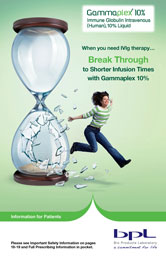Patient Testimonials
Hear a Real Patient Share Her Inspiring Story!
Living With Primary Immunodeficiency
SELECT CHAPTER
Patient Brochure

Gammaplex 10% Patient Brochure
Click here to download the patient brochure for Gammaplex 10%.

Click here to download the patient brochure for Gammaplex 10%.
Gammaplex 10% (immune globulin intravenous [human], 10% liquid) is indicated for replacement therapy in primary humoral immunodeficiency (PI) in adults and pediatric patients two years of age and older. This includes, but is not limited to, the humoral immune defect in common variable immunodeficiency, X-linked agammaglobulinemia, congenital agammaglobulinemia, Wiskott-Aldrich syndrome, and severe combined immunodeficiencies.
Gammaplex 10% is also indicated for the treatment of chronic immune thrombocytopenic purpura (ITP) in adults.
Gammaplex 10% is contraindicated in patients who have had an anaphylactic or severe systemic reaction to the administration of human immune globulin and IgA-deficient patients with antibodies to IgA and a history of hypersensitivity.
In patients at risk of developing acute renal failure, monitor renal function, including blood urea nitrogen (BUN), serum creatinine and urine output. Hyperproteinemia, increased serum viscosity, and hyponatremia may occur in patients receiving IGIV therapy.
Aseptic meningitis syndrome (AMS) may occur with IGIV treatment. AMS usually begins within several hours to 2 days following IGIV treatment. Discontinuation of IGIV treatment has resulted in remission of AMS within several days without sequelae. AMS may occur more frequently in association with high doses (2 g/kg) and/or rapid infusion of IGIV.
Hemolysis and hemolytic anemia can develop subsequent to IGIV treatments. Patient risk factors that may be associated with development of hemolysis include high dose (>2 g/kg), non-O blood group, and underlying inflammatory state. Noncardiogenic pulmonary edema may occur in patients following IGIV treatment (i.e. transfusion-related acute lung injury [TRALI]). Monitor patients for pulmonary adverse reactions. If TRALI is suspected, test product and patient’s serum for anti-neutrophil antibodies.
Gammaplex 10% is made from human plasma and may contain infectious agents, e.g. viruses and, theoretically, the Creutzfeldt-Jakob disease agent. No cases of transmission of viral diseases or CJD have been associated with the use of Gammaplex 10%.
The most common adverse reactions in adult subjects receiving Gammaplex 10% in the PI clinical trial were headache, migraine, and pyrexia. The most common adverse reaction in pediatric subjects receiving Gammaplex 10% in the PI clinical trial was headache. There were no serious product-related adverse reactions observed in adult or pediatric clinical trial subjects with PI. The safety of Gammaplex 10% has not been established in patients with ITP. However, the safety profile for Gammaplex 5% has been studied in subjects with ITP, and it is anticipated that the safety profile for both formulations are comparable for ITP patients. The most common adverse reactions in adult subjects receiving Gammaplex 5% in the chronic ITP clinical trial were headache, vomiting, nausea, pyrexia, arthralgia, and dehydration. Serious adverse reactions observed in clinical trial subjects with ITP were headache, vomiting and dehydration.
Please see Full Prescribing Information for complete prescribing details.
You are encouraged to report negative side effects of prescription drugs to the FDA. Visit http://www.fda.gov/medwatch, or call 1-800-FDA-1088.
You may also call Kedrion at 1-866-398-0825 or email US_Medicalinfo@kedrion.com.